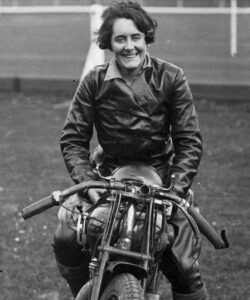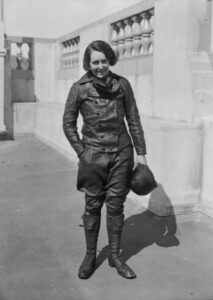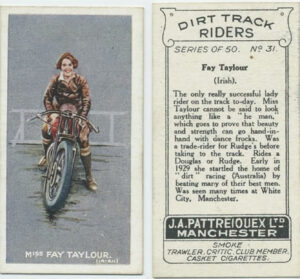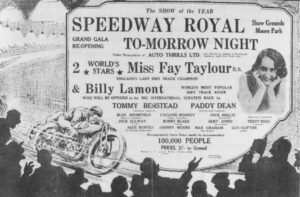It is exceedingly rare for a rider to be as fast on two wheels as four, with racer Sir John Surtees remaining the only person to have won World Championships by both motorcycle and car. Tazio Nuvolari is among the same rank, having achieved wins in individual races on both two and four wheels. The only woman to have secured her place in this esteemed category is Fay Taylour. She started her racing career as a Speedway rider, then went on to race at Brooklands on four wheels, taking her winning streak of speed with her.
Fay Taylour was born in 1904 to a well-heeled family in Ireland, with an aunt involved with the Suffragette movement. When Fay was a teenager, her father, a Surgeon General in the Royal Army Medical Corps, allowed Fay to drive his car to Holloway Prison to pick up said aunt from a stint inside following her arrest at a suffrage protest. Perhaps it was from this – the feeling of female equality – that made Fay realise that she, too, could do anything.
Fay’s grandfather was Lord Wolesley, the Commander in Chief to the British Forces and a favourite of Queen Victoria, whilst Fay’s mother, after attending finishing school in Paris and being presented at court as a debutante, was the belle of many castle balls in Dublin. Throughout the 1920s, Fay’s childhood was a sheltered atmosphere of nannies, pony traps and pastimes a governess would install. However, she soon discovered the ‘boggie car’ (a soap box on wheels) and watched as boys flew past her on the makeshift motors. From then on, it seems she became fascinated by the motion of going fast. She taught herself to ride a bicycle and her father taught her to shoot, fish, and ride horses.
Fay and her father moved to Berkshire after her mother died. Her father took up hobbies to suit a retired gentleman, whilst Fay mainly looked after him. One day, after a slight driving mishap, Fay met a mechanic at the garage fixing her car and he introduced her to motorcycling. She bought a modest 2 -spoke Levis Motorcycle: this marked the beginning of her affair with two-wheeled racing.
Fay entered the Camberley ‘Southern Scott Scramble’ in 1927: a relatively new sport in Britain. The event was created in response to the Northern Trials for the toughest of riders, and held on a circuit of 24 miles for the morning races. In the afternoon, the event hosted the ‘Venus Cup’ for female drivers. Fay was told by her steadfast mechanic that she could beat the top three women trials riders competing.
 Fay practised the course daily to master its several steep hills, and went on to win both the Novice and the Venus Cups. From these wins, Fay was offered a place on the Coventry-based AJS works team, which she accepted alongside an administrative job at the Rudge-Whitworth factory. She soon went on to race in their trials team on a 500cc. Fay became a true motorcycle enthusiast, learning how to assemble and disassemble her bike and winning multiple events against men in different classes in hill climbs and trials, such as the Auto Cycle Union 750-mile six-day trial and the National Alan. Fay was winning enough prize money to earn a small living with the Rudge team.
Fay practised the course daily to master its several steep hills, and went on to win both the Novice and the Venus Cups. From these wins, Fay was offered a place on the Coventry-based AJS works team, which she accepted alongside an administrative job at the Rudge-Whitworth factory. She soon went on to race in their trials team on a 500cc. Fay became a true motorcycle enthusiast, learning how to assemble and disassemble her bike and winning multiple events against men in different classes in hill climbs and trials, such as the Auto Cycle Union 750-mile six-day trial and the National Alan. Fay was winning enough prize money to earn a small living with the Rudge team.
It was at the Speedway, however, where Fay really excelled. After attending (as a spectator) a Speedway race at Stamford Bridge with heats of the cinder racing, Fay was excited to take part. She decided that, as she was an equal challenge with trials and hill climbs, she would try her luck with the dirt track too. The following morning, she went off to ‘Lewis’ Leathers’ and got kitted up for her first race.
It was in that shop that she met Lionel Wills, an English Speedway racer and heir to the wealthy W. D. and H. O. Wills tobacco industrialists. He had just walked in and the shop owner Sammy introduced Fay as ‘the girl who had won those cups at Camberley.’ The two struck up a great friendship.
Wills then introduced her to Freddie Mockford, the manager of the track at Crystal Palace, who kindly agreed to allow Fay seven days’ practice with a race at the end.
 At that time, the ACU forbade women from competing in Speedway leagues, although they were allowed to compete as individuals in non-league races. On 9th June 1928, Fay took part in a Speedway race, becoming the first woman in England to do so. Although she did not win, she did more than enough to earn her place on the track. Tumble after tumble, Fay taught herself to ‘broadslide’ on her heavy Rudge trials bike. She opened up the throttle at the start of the turn and held it open all the way round. Fay soon became known as ‘Flying Fay.’
At that time, the ACU forbade women from competing in Speedway leagues, although they were allowed to compete as individuals in non-league races. On 9th June 1928, Fay took part in a Speedway race, becoming the first woman in England to do so. Although she did not win, she did more than enough to earn her place on the track. Tumble after tumble, Fay taught herself to ‘broadslide’ on her heavy Rudge trials bike. She opened up the throttle at the start of the turn and held it open all the way round. Fay soon became known as ‘Flying Fay.’
Fay had persuaded her uncle Lord Riddle, owner of the News of the World newspaper, to watch her first competitive outing, as well as asking him to wave the starting flag. He, in turn, bestowed The News of the World Trophy for the first number of prizes, whilst providing Fay with an abundance of publicity. By the end of the summer, she attracted huge crowds and won significant prize money.
“The prospect of watching a lady rider, Miss Fay Taylour, matched in a handicap race against a star such as Ron Johnson was chiefly responsible for the excellent crowd at Crystal Palace Speedway last Saturday.” – , 13th June 1928.
The only other woman of note racing alongside Fay was Yorkshire woman Eva Asquith, who had learnt to ride a motorcycle whilst serving in the army. Eva raced with a Special TT AJS and entered the Scottish Six-Day Trial, winning a competitors’ medal for finishing, also coming second in a trial from York to Edinburgh. The Leeds Speedway opened in March 1929 and Eva entered on a special dirt-track Douglas bike purchased from prize money; she was soon totting up the wins.
 Eva thought nothing of sticking her bike in the in the guards’ van on the train to her race meetings, whilst Fay – who often raced alongside Lionel – popped her bike in the back of Wills’ Rolls Royce. With opposite riding styles, both women gave the other riders stiff competition. When the two women would race each other, sparks would fly and excite the crowds with enormous publicity: the Speedway venues were full.
Eva thought nothing of sticking her bike in the in the guards’ van on the train to her race meetings, whilst Fay – who often raced alongside Lionel – popped her bike in the back of Wills’ Rolls Royce. With opposite riding styles, both women gave the other riders stiff competition. When the two women would race each other, sparks would fly and excite the crowds with enormous publicity: the Speedway venues were full.
As winter set in, Fay returned to Ireland for the first time as a racer, while the Belfast News announced her: ‘Stars dashing performance at Windsor Park Track, Lady champion a favourite …Powder puff on the dirt track.’
Whilst Fay may not have won her races, coming third with a time of only 3 seconds slower than the winner, she certainly brought attention to the sport. Speedway organisers all over the United Kingdom booked Fay whenever there was a race, and Fay obliged to be present. However, during one trip from Ireland to Salford for a race meet, Fay missed the boat. She managed to get her bike there separately and Fay managed to get on a cargo of pigs across the Irish Sea, only to arrive as the racing was finishing. Fay begged the organisers to let her provide her fans with a presentation and they loved it.
After the British season ended in 1928, Eva went to Denmark and pulled in a crowd of over 10,000, while Fay went to Australia to work the circuits there. Both women were the first people from the United Kingdom, let alone women, to take their Speedway passions overseas.
 Fay had enormous success in Australia and New Zealand, racing against Sig Schlam, equalling track records, winning and bringing in the crowds. ‘Flying Fay’ from Dublin was featured on cigarette cards, pictured in her scarlet leathers emblazoned with an Irish flag, and was a regular celebrity guest on radio shows. She was a worthy hit with both Douglas the bike manufacturers and the crowds.
Fay had enormous success in Australia and New Zealand, racing against Sig Schlam, equalling track records, winning and bringing in the crowds. ‘Flying Fay’ from Dublin was featured on cigarette cards, pictured in her scarlet leathers emblazoned with an Irish flag, and was a regular celebrity guest on radio shows. She was a worthy hit with both Douglas the bike manufacturers and the crowds.
During her visit to Australia, however, Fay had a terrible crash at the Royal Agricultural showgrounds Speedway in Sydney. This circuit was claimed to be the fastest in Australia with a rough cinder surface.
Fay recalled that her first race was a handicap heat. The mechanic who pushed her off had warned her to take it easy, saying that the first and second fastest riders would go into the final. She remembered overtaking one rider before losing control and slamming into the fence (which was notable for many a crash). This was all she could remember of the race when she woke up in hospital, wearing the most ‘appalling flannel nightdress.’ Since then, she was forever known for carrying pink silk pyjamas to the circuit as a lucky omen.
Returning to Tilbury Docks for the start of the season in 1929, Fay was met by Vic Deal of the Wembley Speedway League and presented with a bouquet of red and white roses. She then rushed off to see Lionel Wills at his offices in London; their relationship was built upon a mutual respect for the Speedway, but he later married someone else for true love. Fay never ended up marrying.
 Fay’s Speedway career was limited to just the three seasons between 1928 and 1930. After this, the Auto Cycle Union banned female riders after one of them fell off her bike and broke her collarbone in a pre-meeting parade at Wembley.
Fay’s Speedway career was limited to just the three seasons between 1928 and 1930. After this, the Auto Cycle Union banned female riders after one of them fell off her bike and broke her collarbone in a pre-meeting parade at Wembley.
Undeterred, Fay moved to four wheels and competed in the Calcutta to Ranchi Run: 291 miles of hard terrain in a Chevrolet which broke the record for the event. So impressed was the previous holder of the event that he introduced Fay to Brooklands. Fay took part in the women’s handicap race in the Autumn of 1931 driving a Talbot 105, where she lapped at 107.80 mph. In a similar race at Brooklands in the autumn of the following year, Fay came second, lapping at 113.97 mph.
She won her first hill climb at Shelsley Walsh, and the Class Cup in Ulster at the Craignet Hill Climb. Fay then went on to win the women’s race at Donington, then won the famous mountain circuit at Brooklands in 1934 while driving a supercharged Alfa Romeo: this win broke the lap record set by Malcom Campbell. Other women competing in that race were Doreen Evans, and Elsie Wisdom, who came third place in a Talbot. Fay drove a works Aston Martin in the Italian Mille Miglia, being the only woman in the race. Fay raced for Freddie Dixon in his Riley at the 1938 South African Grand Prix, as Dixon had had his license revoked.
Her racing clothes included a jumper and a tweed skirt which, knowing Fay, would have her pink silk pyjamas safely packed within her luggage.
During the war years, Fay involved herself with Oswald Mosley and the right-wing British Union of Fascists, before he had started his affair with one of the Mitford sisters. As a result, Fay was thrown into prison between the years of 1940 and 1943 in Holloway and on the Isle of Man. I wonder if she thought of her aunt some years previous to being interned at the same hospitality for a slightly different cause.
MI5 described her as: ‘One of the worst pro-Nazis in Port Erin… she is in the habit of hoarding pictures of Hitler and had in her possession a hymn in which his name was substituted for God’s.’
Fay returned to Ireland in 1944, where she stayed at the headquarters of the Girls’ Friendly Society in Upper Merrion Street, Dublin, and had started to work for a company selling farm harvest machinery. In 1949 she moved to Los Angeles, sold Jaguars and MGs, and took up midget car racing with the young Stirling Moss amongst her competitors. After retirement in the late 1950s, she went to live at Blandford in Dorset, dying from a stroke in 1983.
To me, Fay’s racing achievements have been overshadowed by her involvement with the right-wing regime. To say Fay was an amazing woman would be an untruth; she was an amazing racer, so I take her race results with merit and think who else I might introduce you next time.
It will be Elsie Wisdom, whom I think you will adore.
Until next time,
Lara